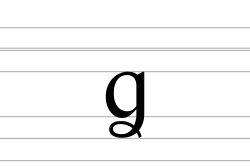Cross-tailed G
| Cross-tailed g | |
|---|---|
| ꬶ | |
 | |
| Usage | |
| Writing system | Latin script |
| Type | Alphabet |
| Language of origin | Teuthonista |
| Sound values | [gʲ], [ɣ] |
| History | |
| Development | |
| Transliterations | Ꞔ ꞔ |
| Other | |
| Writing direction | Left-to-Right |
ꬶ (lowercase only) is a letter of the Latin alphabet.[1]
ꬶ was used in Teuthonista for the purposes of German dialectology, prior to the development of the International Phonetic Alphabet.[2][3]
Usage
In 1893, Otto Bremer used a cross-tailed g to represent a palatalizated voiced velar plosive [gʲ] in his phonetic transcription, but he replaced it with g with inverted breve ⟨g̑⟩. It has also been used in other transcriptions, like Arwid Johannson's Phonetics of the New High German language[4] or Edmund Crosby Quiggin's Donegal Irish dialect transcription, in which it represents the voiced velar fricative [ɣ].
Gallery
Encoding
| Preview | ꬶ | |
|---|---|---|
| Unicode name | LATIN SMALL LETTER SCRIPT G WITH CROSSED-TAIL | |
| Encodings | decimal | hex |
| Unicode | 43830 | U+AB36 |
| UTF-8 | 234 172 182 | EA AC B6 |
| Numeric character reference | ꬶ |
ꬶ |
References
- ^ "ꬶ". graphemica. Retrieved 19 January 2020.
- ^ "Universal Multiple-Octet Coded Character Set" (PDF). unicode.org. 2 June 2011. Retrieved 28 March 2023.
- ^ Sammlung kurzer Grammatiken deutscher Mundarten (in German). Leipzig, Breitkopf und Härtel, coll. 1893.
- ^ Williams, R. A.; Johannson, Arwid (July 1906). "Phonetics of the New High German Language". The Modern Language Review. 1 (4): 345. doi:10.2307/3713467. ISSN 0026-7937.


